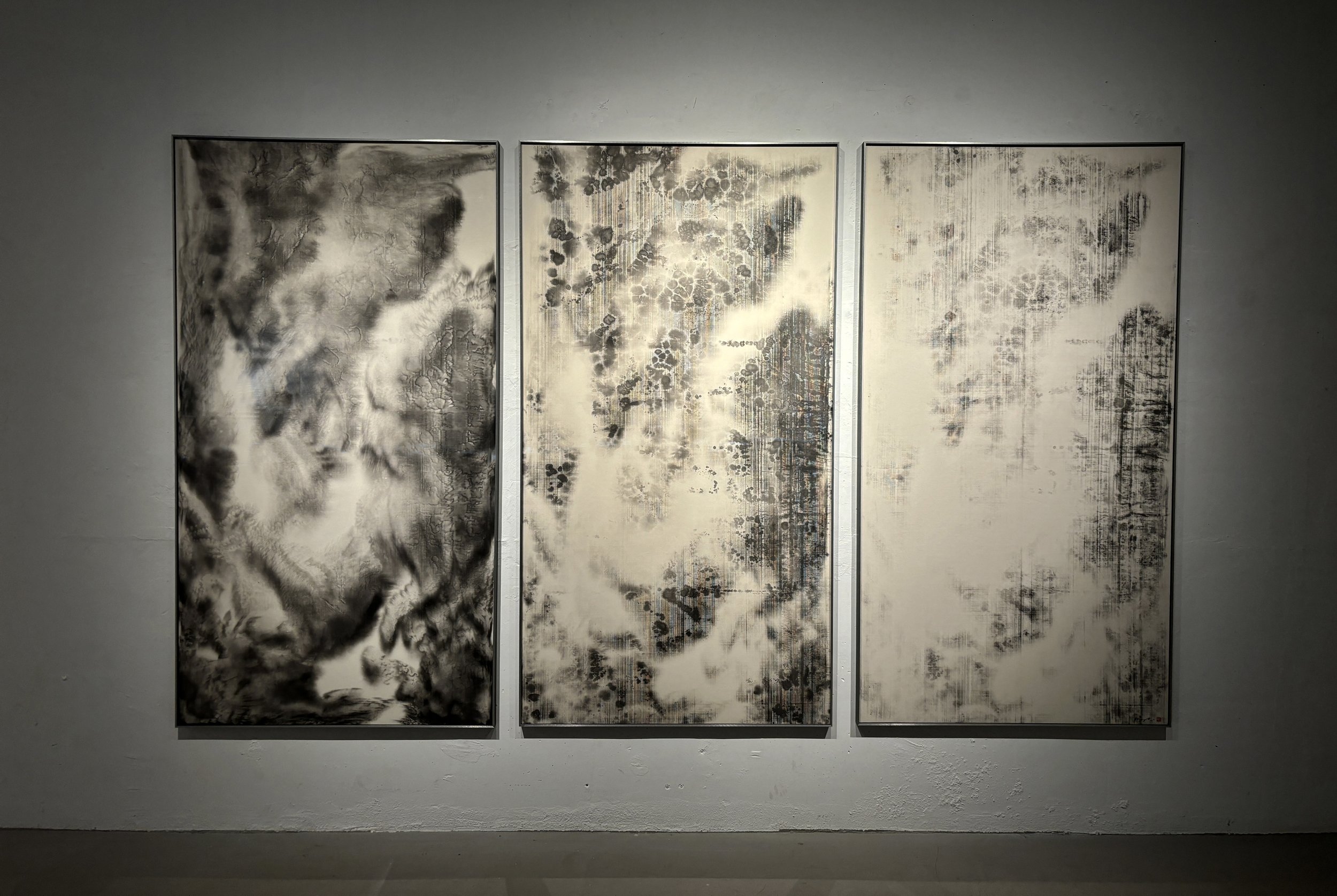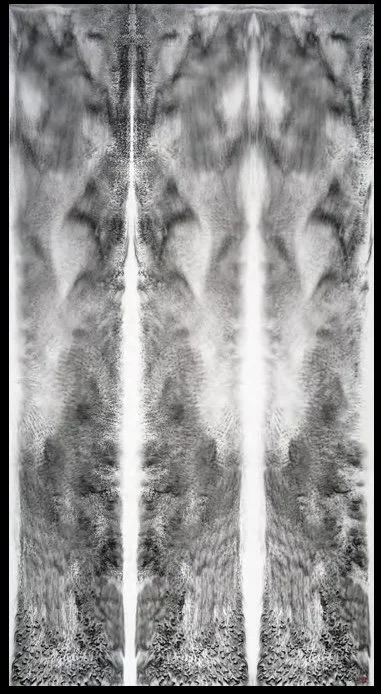HUNG Fai
熊輝
HUNG Fai (b. 1988 in Hong Kong) graduated from the Fine Arts Department of The Chinese University of Hong Kong in 2013. Exploring both Chinese and Western media, Hung has developed unique expression and presentation techniques on both paper and canvas. Through deconstruction of elements in traditional Chinese ink paintings, his works are reconstructed conceptually with series of experimentation and transformation, and extend possibilities in ink painting.
Hung has been exhibited in museums, institutions, galleries and art fairs including ‘The Weight of Lightness: Ink Art,’ M+ Museum, Hong Kong, 2017; ‘Wild Imagination - Contemporary Ink Art in Guangdong-Hong Kong-Macao from 2000 to 2020,’ Guangdong Museum of Art, 2020; ‘Kathmandu Triennale 2077,’ Kathmandu, 2022; ‘Garden of Six Seasons,’ Para Site, 2020; Art Basel, Hong Kong (2014-2021) ; Fine Art Asia (2013-2021) and Ink Asia (2015-2019). His solo exhibitions include ‘The Departing Landscape – Hung Fai Ink Project,’ (2016) and ‘Movement - Hung Fai’ (2014) both in Grotto Gallery, Hong Kong. Hung has received the Honourable Mention – Liu Kuo Sung Ink Art Award 2019; Certificate of Merit - The Twelfth National Exhibition of Fine Arts, China 2014.
His work is in the collections of M+ Museum for Visual Culture, Hong Kong and the Hong Kong Museum of Art, as well as various private collections.
熊輝 (1988年生於香港) ,2013年從香港中文大學畢業,主修藝術。對中西媒介專進行探索和實驗,重新演繹水墨藝術,並發展出一套獨特的技法及表現形式。作品籍着解構傳統水墨媒介的元素,以概念重塑繪畫,經實驗、轉化,賦予其新的意義及可能性。
曾參於《似重若輕:M+水墨藏品》 (香港M+,2017)、《臆象—粵港澳當代水墨藝術譜系(2000-2020)》(廣東美術館,2020)、《加德滿都三年展2077》(加德滿都,2022) 、《一園六季》(Para Site藝術空間,2020)及香港巴塞爾藝術展 (2014-2022)、典亞藝博 (2013-2021)、水墨藝博 (2015-2019)。並於嘉圖現代藝術舉辨個展《山水重構—熊輝水墨計劃》(2016) 和《變法—熊輝》(2014)。曾獲「劉國松水墨藝術奬榮譽奬」(2019)、「第十二屆全國美展優秀獎」(2014)等。
作品獲香港 M+ 視覺文化博物館、香港藝術館及私人收藏。
Selected Solo Exhibitions
2016
The Departing Landscape - Hung Fai Ink Project 《山水重構——熊輝水墨計劃》- Grotto Central
Movement 《變法——熊輝》- Grotto Central
2014
Selected Joint Exhibitions
2025
2024
2024
2023
2022
Collections
M+, Hong Kong
Hong Kong Museum of Art
Selected Works
Transmission X
-
HUNG Fai 熊輝
The Six Principles of Chinese Painting- Transmission X (with Hung Hoi)
2016
147.5x149cm
Ink and colour on paper -
The concept of Hung Fai’s “The Six Principles of Chinese Painting: Transmission by Coping”* stemmed from the perception of model and transmission in Chinese painting. Through the act of inviting his father, Hung Hoi, to paint a model landscape, Hung Fai reversed the traditional relationship between the transmitted (the father) and the transmitter (the son). The usage of ink dots, water and folding rice paper created a new method that allowed Hung to deconstruct the conventional notion of “red landscape" which symbolizes authority. The sensibility of tracing and the physicality of deconstructing materials was indeed a contrasting methodology. The resulting work, a departing landscape, ultimately transformed and reconstructed tradition, authority and familial relationship.
In this new Transmission Series, Hung Fai once again collaborated with his father on conceptualizing and creating a landscape composition. Hung Hoi first painted in cinnabar red color a model landscape. With the paper folded and saturated, Hung Fai delineated the model with black ink dots. Traces of the ink created subtle, faded silhouette as penetrated through layers of folded paper. Upon unfolding there appeared an image deconstructed and transformed from the original model.
At the completion of the last panel, Hung Fai asked Hung Hoi: “Of this last image, what does the faded marks look like?” He then asked his father to paint over the faded ink marks his interpretation of the last panel. By extending the conceptual framework through re-inviting his father to paint the end panel, Hung Fai fully manifested the relationship between landscape, tradition, authority and family; and most importantly suggested a state of endless creative cycle which underlies the artist’s contemporary spirit.
* “The Six principles of Chinese Painting: Transmission” was established by Xie He, a Chinese painter and art critic in sixth century AD, in the preface of his book "The Record of the Classification of Old Painters".
作品重新演釋「繪畫六法:傳移模寫」*,在概念框架下,主動邀請父親以硃砂物料繪畫以山水為主題的範本,逆轉傳統中被臨摹者(父親)與臨摹者(兒子)的關係。以墨點描摹,利用水、墨、紙的物理性,解構象徵權威的紅色山水。感受性的描摹經驗與物理性的解構手法形成反差。分離、消散的山水,最終被轉化和重構,成為呈現其與傳統、權威和父子之間關係的載體。
在「傳移模寫」的新系列,熊輝邀請父親──熊海──於宣紙上以硃砂繪畫山水作為範本,先將其摺疊、濕透,再於山水的上層以墨點描摹。墨水經層層滲透,穿透紅色山水,留下隱約、消逝的墨痕。展開的畫面,紀錄對範本的解構和轉換的過程。
最後熊輝問熊海:「最終這幅,那消逝的墨痕像甚麼?」請父親於墨痕上以硃砂畫下他的聯想,以紀錄他的回應。 藉著記錄雙方的表述,延伸了概念框架的完整性。完整地體現山水與傳統、權威和父子之間的關係,呈現一種無盡、具創造性的循環狀態,並由此反映了藝術家的當代精神。
*「繪畫六法:傳移模寫」出自六世紀時的中國畫家、藝術理論家謝赫,載於其著作《古畫品錄》中的序論。
Trace IV
-
HUNG Fai 熊輝
Traces IV 《痕》之四
2022
Ink on paper
180 x 291cm (triptych), 180 x 96.5cm each panel -
The creation of this triptych began with the left panel, where ink flowed and diffused across soaked paper, leaving traces akin to memories. Water acted as a carrier, storing both ink marks and memories within the layers of paper. Hung Fai then placed two dry sheets on top, pressing them gently to reveal ink flecks. Using an inkless pen, he inscribed invisible lines that appeared to tear the surface, allowing ink to leak and form a transparent net. This net intertwined the old and new marks. Finally, the layers were spread across three panels, connecting the ink traces and memories from left to right. The right panel captured the disappearing and emerging traces. “Traces IV” recorded the transformation and relationships of water, traces and memories.
此三聯畫的創作始於左幅,墨水在濕紙上流淌滲化,留下如同記憶的痕跡。水作為載體,將墨跡和記憶儲存在紙層中。熊輝接著覆蓋兩張乾紙,輕輕拍打後,墨跡浮現。他用無墨的硬筆劃下透明線條,表層猶如被劃破般讓墨滲出,形成交織的透明網,將新舊痕跡纏繞。最後,紙層展開,從左至右連接墨跡和記憶,右幅捕捉了消失與顯現的痕跡。《痕》之四記錄了水、痕跡和記憶之間的轉化。





